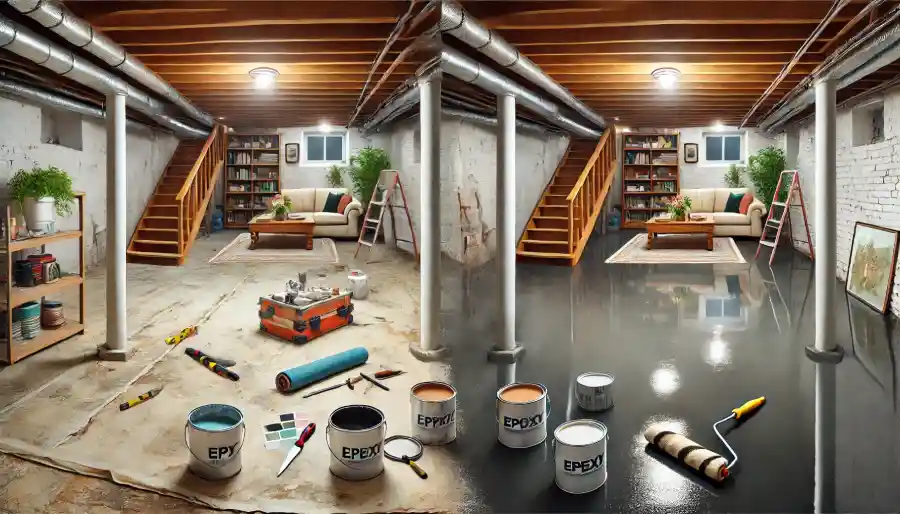Transforming Your Basement Floor: Comprehensive Guide to Epoxy Flooring
Key Takeaways
- Epoxy flooring can transform your basement into a durable and aesthetically pleasing space.
- Preparation, application, and finishing are crucial to achieving a high-quality epoxy floor.
- Your epoxy floor’s endurance and aesthetic appeal are guaranteed with proper care.
- Epoxy flooring offers various benefits, including durability, ease of cleaning, and aesthetic appeal.
- Considering color, design, and environment can enhance the basement floor transformation.
Benefits of Epoxy Flooring
With so many benefits, epoxy flooring is growing in popularity. It offers durability, resistance to stains, and ease of maintenance, making it an ideal basement choice. Additionally, epoxy floors provide a modern look that can enhance any basement space. Working with a professional epoxy floor installer can ensure the best results for those considering a basement renovation.
Not only is epoxy flooring extremely durable, but it is also highly resistant to various chemicals, benefitting those seeking robust protection against spills. Epoxy floors additionally offer a sleek and appealing finish. This makes epoxy flooring not only practical but also visually attractive, adding value to your home.
Preparing Your Basement Floor
Preparation is vital to any successful epoxy floor installation. This step involves cleaning the floor thoroughly and repairing any cracks or damages. It’s critical to remove all debris and ensure the floor is dry. Some experts recommend grinding the floor to create a better surface to which the epoxy can adhere.
Ensuring that every inch of the basement floor is adequately prepared can significantly affect the outcome. A poorly prepared floor might result in the epoxy not adhering correctly or appearing uneven. Therefore, taking extra time in the preparation phase can save time and money in the long run by avoiding repairs or reapplication.
Step-by-Step Epoxy Flooring Application
- Mix the Epoxy: The first step in applying epoxy is to mix the resin and hardener according to the manufacturer’s instructions. This mixture should be done precisely, as incorrect proportions can affect the curing and durability of the floor.
- Apply the Primer: A primer helps the epoxy adhere better to the floor. It should be applied evenly and allowed to dry. The primer also plays a crucial role in sealing the concrete floor, preventing any moisture from coming up through the floor.
- Apply the Epoxy: Apply the epoxy mixture after the primer has dried. Use a roller for even application and work in small sections to ensure thorough coverage. Working quickly yet carefully is necessary to prevent air bubbles and guarantee a flawless finish.
- Allow to Cure: Curing times can vary, but the epoxy generally takes around 24 hours to set. Keep the area well-ventilated during this period. Ensure the curing process is undisturbed for the best results; avoid walking on the floor or placing any objects until fully cured.
Finishing Touches for a Professional Look
Consider adding a topcoat to achieve a professional finish. Depending on your preference, this can add extra durability and provide a gloss or matte finish. Adding texture, such as flakes or metallic pigments, can enhance the overall appearance.
These finishing touches contribute to the floor’s aesthetic appeal and improve its functionality. A textured surface can provide additional traction, making the floor less slippery and safer, especially in damp areas like basements. Customizing the topcoat can also make your basement floor unique and tailored to your style.
Maintaining Your Epoxy Floor
An epoxy floor is effortless to maintain. You can keep the floor immaculate with routine sweeping and seldom wiping with a mild cleaner. Steer clear of solid chemicals and abrasive cleaning equipment. A consistent maintenance program guarantees that your epoxy floor will look great for many years.
Proper and consistent maintenance will not only preserve the glossy finish but also help detect any wear or damage early, which can be addressed promptly to maintain the integrity of the floor.
Design Tips for Epoxy Floors
Epoxy floors offer various design options, from solid colors to intricate patterns. Metallic epoxies create a marble-like effect, adding elegance to your basement. Brighter lighting can highlight the glossy finish. For a unified effect, think about how your floor design will work with the rest of your basement space in addition to color and pattern. Epoxy floors can fit into various themes, such as modern, industrial, or classic, making them versatile and adaptable.
Environmental Considerations
Epoxy floors are durable and environmentally friendly due to their low VOC content, making them safer for indoor installations. Their longevity reduces waste and contributes to a more sustainable home improvement strategy. Investing in high-quality, long-lasting materials reduces the need for frequent replacements, benefiting both the wallet and the planet. Epoxy flooring is a sustainable choice for creating an eco-friendly home.

